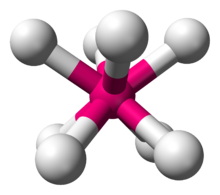Square antiprismatic molecular geometry
Appearance
| Square antiprismatic molecular geometry | |
|---|---|
 |
In chemistry, the square antiprismatic molecular geometry, or cubic geometry describes the shape of compounds where eight atoms, groups of atoms, or ligands are arranged around a central atom, defining the vertices of a square antiprism.[1]
Like with other high coordination numbers, eight-coordinate compounds are often distorted from idealized geometries, as illustrated by the structure of Na3TaF8. In this case, with the small Na+ ions, lattice forces are strong. With the diatomic cation NO+, the lattice forces are weaker, such as in (NO)2XeF8, which crystallizes with a more idealized square antiprismatic geometry.
-
The distorted square antiprismatic [TaF8]3- anion in the Na3TaF8 lattice.[2]
-
The square antiprismatic [XeF8]2- anion in the lattice of nitrosonium octafluoroxenate(VI), (NO)2XeF8.[3]
Examples
- XeF2−
8 - IF−
8 - ReF−
8 - ZrF4−
8
References
- ^ D. L. Kepert (1978). "Aspects of the Stereochemistry of Eight-Coordination". Progress in Inorganic Chemistry. 24: 179–249. doi:10.1002/9780470166253.ch4.
- ^ "Redetermination of Na3TaF8". Acta Crystallographica, Section C: Crystal Structure Communications. 66: pi85–pi86. 2010. doi:10.1107/S0108270110030556.
{{cite journal}}: Unknown parameter|authors=ignored (help) - ^ Peterson, W.; Holloway, H.; Coyle, A.; Williams, M. (Sep 1971). "Antiprismatic Coordination about Xenon: the Structure of Nitrosonium Octafluoroxenate(VI)". Science. 173 (4003): 1238–1239. Bibcode:1971Sci...173.1238P. doi:10.1126/science.173.4003.1238. ISSN 0036-8075. PMID 17775218.
{{cite journal}}: Cite has empty unknown parameter:|month=(help)

![The distorted square antiprismatic [TaF8]3- anion in the Na3TaF8 lattice.[2]](http://upload.wikimedia.org/wikipedia/commons/thumb/0/02/TaF83-Core.png/130px-TaF83-Core.png)
![The square antiprismatic [XeF8]2- anion in the lattice of nitrosonium octafluoroxenate(VI), (NO)2XeF8.[3]](http://upload.wikimedia.org/wikipedia/commons/thumb/3/30/Octafluoroxenate%28VI%29-3D-balls-A.png/164px-Octafluoroxenate%28VI%29-3D-balls-A.png)